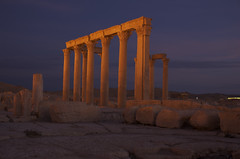Today was the first time I saw the sun this year. I had almost forgotten what it looked like; it was nice. I went to the lab for a miniprep, a restriction digest and a gel and used the time the experiments took to go for a run in the park. Mileage is really picking up. I will probably double last year's preparation, certainly in terms of distance and hopefully also in terms of intensity.
When I was done with the running and experimenting and had packed everything up neatly, I headed down to South Kensington for a coffee but got sidetracked as soon as I left the building. The entire length of the Queen's Lawn runs an exhibition of the Hard Rain Project.
I had noticed the open-air gallery from my office window and passed it frequently on my way to lunch over the past few days but never quite found the time to have a close look, despite the exhibition's alluring sell: A man's quest to represent in photography each line of Bob Dylan's eternal A Hard Rain's a-Gonna Fall. Sounds good? Well, this afternoon I finally spent half an hour contemplating the three dozen photos or so.
This is not just an exercise in illustration. The project's mission is to "Reinvent the modern world so it's compatible with nature and human nature". The strategy is to pair Dylan's most apocalyptic song with apposite photos, spreading the doom and gloom of human suffering and of the erosion of the natural world. I'm not sure this is the right approach.
Some of the photos are truly heartbreaking (though the one of Abu Ghraib seems to have been added only to blatantly flatter the liberal, Bush-hating target audience), and I was left rather despondent after seeing them all. After the oil scare of the last few years, water is making a big comeback as commodity of scarcity, melting off glaciers and being pumped out of aquifers left and right until the world becomes one big dust bowl. Our climate is on its way to hell, and we're going with it unless we do something.
The problem is certainly correctly identified, but spreading dejection and fuzzy catch lines is not going to lead to solutions. Visionary ideas and inspiration might, but optimism and can-do were nowhere to be found among the misery of wars, hunger and climate catastrophe. And yet, optimism and inspiring plans are the only way to go. As the saying goes, Whether you think you can do it or you think you can't, you're usually right.
Not many people truly care about glaciers being lost. They're too far away and don't have a perceivable effect on people's lives, important though they are. I lost an SD card the other day and was rather distressed. Some photos were gone forever and my camera went out of commission yet again. This loss had an immediate effect on me and caused me to act, though on a global scale, it didn't matter one little bit.
Similarly, you won't get Joe Public to passionately and tirelessly fight to end the war in Sudan or prevent the submerging of Bangladesh. There's always something closer to home that's more important. That's obviously where conservation and protection of the environment begin, but they need to begin in the same way all over the world.
La Paz is going to run out of water in forty years, or so the prediction goes (and if you believe 40-year predictions, you're a fine fool), but few people there care. There more concerned about getting a job for the day so they can put food on the table at night. This is where the solution starts.
What's needed are positive, constructive ideas that can be realized and make a measurable difference. Some of those already exist. Glaciers melt and sea levels rise? Just take the meltwater back out of the ocean. How hard can it be? Use solar power to drive desalination, creating freshwater in areas that are most in need. Pump the stuff up to La Paz if need be.
Closer to implementation is an plan that promises to solve much of the water problem of Jordan and save the Dead Sea from vanishing at the same time. Take water from the Red Sea, use the sun to recover drinking water and let the remaining brine jet down to the Dead Sea. Put some turbines right at the bottom and capture the potential energy of liquid that started its journey 400m higher.
A visionary approach is needed to prevent the world from collapsing, not another set of depressing photos. People must be galvanized to act, not paralyzed into despair. And the song doesn't need the photos either.

1 comment:
Great post Andreas, although I have a different take! I see your point, although somehow awareness must be raised so that the creative can-do solutions can be inspired. For this it helps to reach a broad audience, in hopes of catching the "right" person. You are correct that the message will fall upon mostly deaf ears that have more immediate concerns. I find these types of exhibits make me feel helpless as it is not possible to even begin to address all the wrongs of the world. I also feel in some ways that those behind these messages are being superficial or just showcasing their political ideals to their peers. However, in a different light, they are using their talent to bring the issues out in the open. Hopefully, in an indirect way, this may even lead to a solution. Sometimes, it takes shocking people to get them to act.
Post a Comment